Strategic Management: Determining Strategies for Tesco Analysis
VerifiedAdded on 2022/11/29
|11
|3366
|78
Report
AI Summary
This report delves into the core concepts of strategic management, outlining the processes involved in determining effective strategies for an organization. It emphasizes the importance of setting clear goals, gathering and analyzing information, formulating and implementing strategies, and continuous evaluation and control. The report uses Tesco, a multinational retail company, as a case study to illustrate these concepts. It explores various tools used in strategic management, including PESTLE and SWOT analyses, and demonstrates their application in the context of Tesco's operations. Furthermore, the report highlights the significance of change management in navigating complexities, costs, risks, and sustainability within the transformation process. The analysis provides a comprehensive understanding of how strategic management principles can be applied to achieve competitive advantage and organizational success.
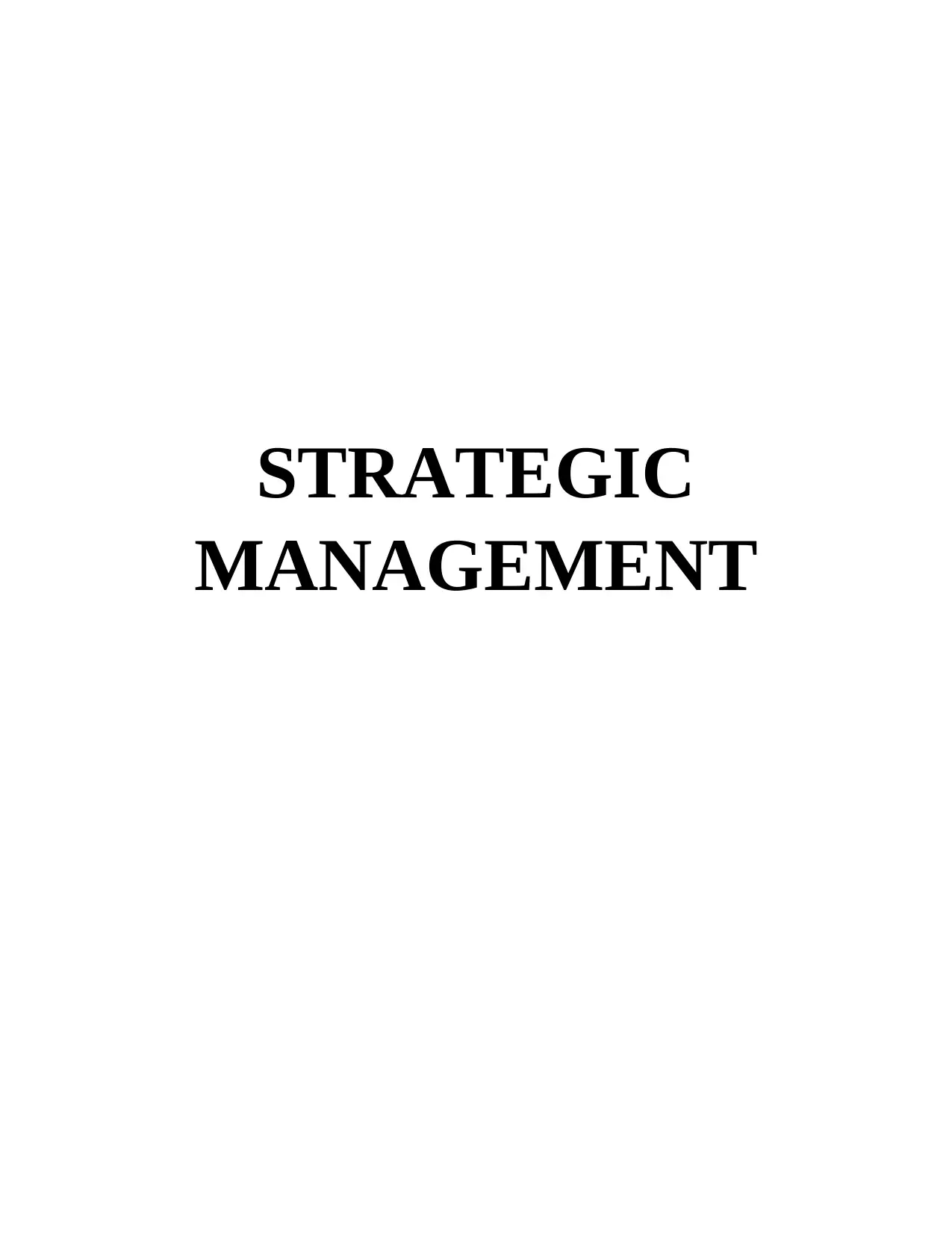
STRATEGIC
MANAGEMENT
MANAGEMENT
Paraphrase This Document
Need a fresh take? Get an instant paraphrase of this document with our AI Paraphraser
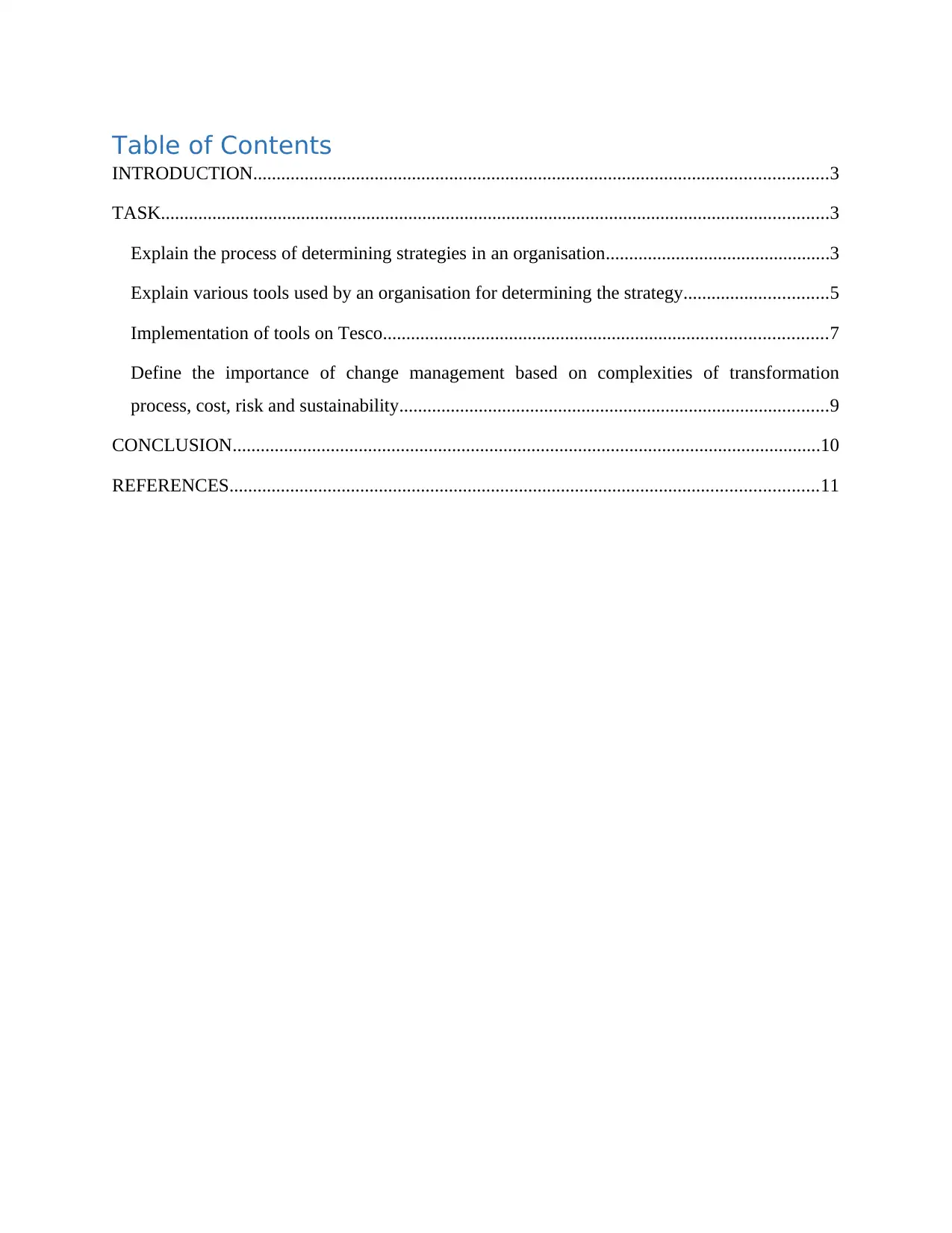
Table of Contents
INTRODUCTION...........................................................................................................................3
TASK...............................................................................................................................................3
Explain the process of determining strategies in an organisation................................................3
Explain various tools used by an organisation for determining the strategy...............................5
Implementation of tools on Tesco...............................................................................................7
Define the importance of change management based on complexities of transformation
process, cost, risk and sustainability............................................................................................9
CONCLUSION..............................................................................................................................10
REFERENCES..............................................................................................................................11
INTRODUCTION...........................................................................................................................3
TASK...............................................................................................................................................3
Explain the process of determining strategies in an organisation................................................3
Explain various tools used by an organisation for determining the strategy...............................5
Implementation of tools on Tesco...............................................................................................7
Define the importance of change management based on complexities of transformation
process, cost, risk and sustainability............................................................................................9
CONCLUSION..............................................................................................................................10
REFERENCES..............................................................................................................................11
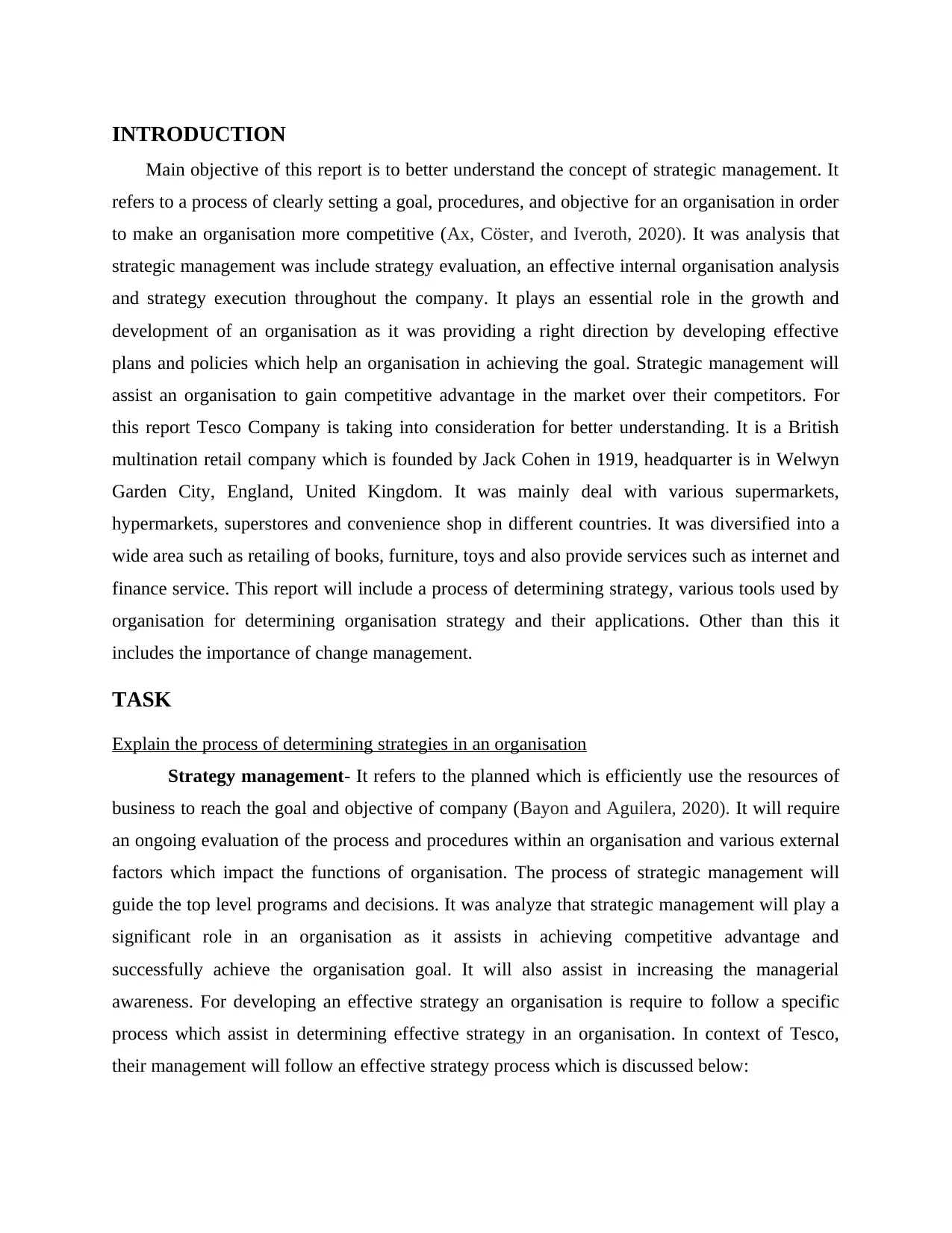
INTRODUCTION
Main objective of this report is to better understand the concept of strategic management. It
refers to a process of clearly setting a goal, procedures, and objective for an organisation in order
to make an organisation more competitive (Ax, Cöster, and Iveroth, 2020). It was analysis that
strategic management was include strategy evaluation, an effective internal organisation analysis
and strategy execution throughout the company. It plays an essential role in the growth and
development of an organisation as it was providing a right direction by developing effective
plans and policies which help an organisation in achieving the goal. Strategic management will
assist an organisation to gain competitive advantage in the market over their competitors. For
this report Tesco Company is taking into consideration for better understanding. It is a British
multination retail company which is founded by Jack Cohen in 1919, headquarter is in Welwyn
Garden City, England, United Kingdom. It was mainly deal with various supermarkets,
hypermarkets, superstores and convenience shop in different countries. It was diversified into a
wide area such as retailing of books, furniture, toys and also provide services such as internet and
finance service. This report will include a process of determining strategy, various tools used by
organisation for determining organisation strategy and their applications. Other than this it
includes the importance of change management.
TASK
Explain the process of determining strategies in an organisation
Strategy management- It refers to the planned which is efficiently use the resources of
business to reach the goal and objective of company (Bayon and Aguilera, 2020). It will require
an ongoing evaluation of the process and procedures within an organisation and various external
factors which impact the functions of organisation. The process of strategic management will
guide the top level programs and decisions. It was analyze that strategic management will play a
significant role in an organisation as it assists in achieving competitive advantage and
successfully achieve the organisation goal. It will also assist in increasing the managerial
awareness. For developing an effective strategy an organisation is require to follow a specific
process which assist in determining effective strategy in an organisation. In context of Tesco,
their management will follow an effective strategy process which is discussed below:
Main objective of this report is to better understand the concept of strategic management. It
refers to a process of clearly setting a goal, procedures, and objective for an organisation in order
to make an organisation more competitive (Ax, Cöster, and Iveroth, 2020). It was analysis that
strategic management was include strategy evaluation, an effective internal organisation analysis
and strategy execution throughout the company. It plays an essential role in the growth and
development of an organisation as it was providing a right direction by developing effective
plans and policies which help an organisation in achieving the goal. Strategic management will
assist an organisation to gain competitive advantage in the market over their competitors. For
this report Tesco Company is taking into consideration for better understanding. It is a British
multination retail company which is founded by Jack Cohen in 1919, headquarter is in Welwyn
Garden City, England, United Kingdom. It was mainly deal with various supermarkets,
hypermarkets, superstores and convenience shop in different countries. It was diversified into a
wide area such as retailing of books, furniture, toys and also provide services such as internet and
finance service. This report will include a process of determining strategy, various tools used by
organisation for determining organisation strategy and their applications. Other than this it
includes the importance of change management.
TASK
Explain the process of determining strategies in an organisation
Strategy management- It refers to the planned which is efficiently use the resources of
business to reach the goal and objective of company (Bayon and Aguilera, 2020). It will require
an ongoing evaluation of the process and procedures within an organisation and various external
factors which impact the functions of organisation. The process of strategic management will
guide the top level programs and decisions. It was analyze that strategic management will play a
significant role in an organisation as it assists in achieving competitive advantage and
successfully achieve the organisation goal. It will also assist in increasing the managerial
awareness. For developing an effective strategy an organisation is require to follow a specific
process which assist in determining effective strategy in an organisation. In context of Tesco,
their management will follow an effective strategy process which is discussed below:
⊘ This is a preview!⊘
Do you want full access?
Subscribe today to unlock all pages.

Trusted by 1+ million students worldwide
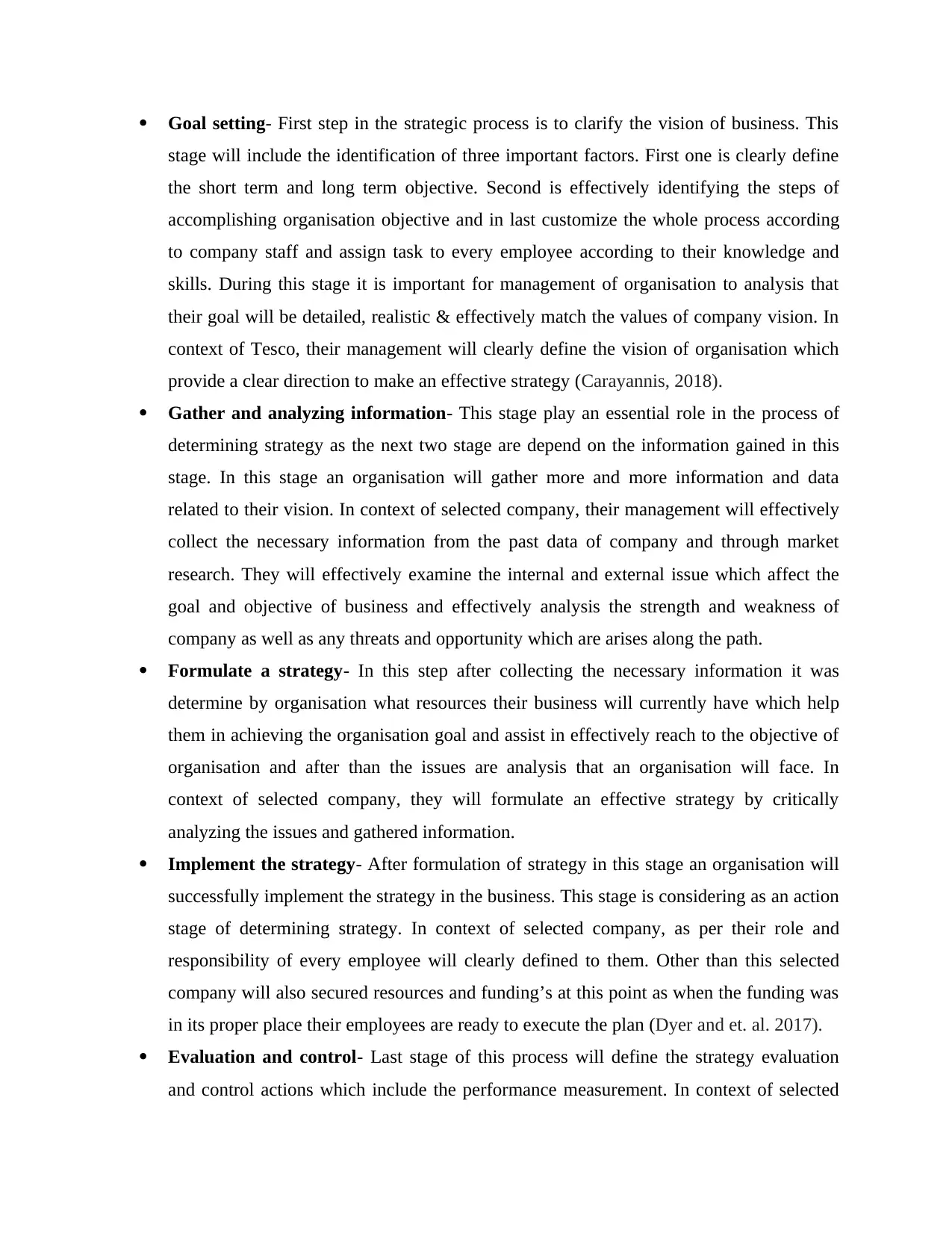
Goal setting- First step in the strategic process is to clarify the vision of business. This
stage will include the identification of three important factors. First one is clearly define
the short term and long term objective. Second is effectively identifying the steps of
accomplishing organisation objective and in last customize the whole process according
to company staff and assign task to every employee according to their knowledge and
skills. During this stage it is important for management of organisation to analysis that
their goal will be detailed, realistic & effectively match the values of company vision. In
context of Tesco, their management will clearly define the vision of organisation which
provide a clear direction to make an effective strategy (Carayannis, 2018).
Gather and analyzing information- This stage play an essential role in the process of
determining strategy as the next two stage are depend on the information gained in this
stage. In this stage an organisation will gather more and more information and data
related to their vision. In context of selected company, their management will effectively
collect the necessary information from the past data of company and through market
research. They will effectively examine the internal and external issue which affect the
goal and objective of business and effectively analysis the strength and weakness of
company as well as any threats and opportunity which are arises along the path.
Formulate a strategy- In this step after collecting the necessary information it was
determine by organisation what resources their business will currently have which help
them in achieving the organisation goal and assist in effectively reach to the objective of
organisation and after than the issues are analysis that an organisation will face. In
context of selected company, they will formulate an effective strategy by critically
analyzing the issues and gathered information.
Implement the strategy- After formulation of strategy in this stage an organisation will
successfully implement the strategy in the business. This stage is considering as an action
stage of determining strategy. In context of selected company, as per their role and
responsibility of every employee will clearly defined to them. Other than this selected
company will also secured resources and funding’s at this point as when the funding was
in its proper place their employees are ready to execute the plan (Dyer and et. al. 2017).
Evaluation and control- Last stage of this process will define the strategy evaluation
and control actions which include the performance measurement. In context of selected
stage will include the identification of three important factors. First one is clearly define
the short term and long term objective. Second is effectively identifying the steps of
accomplishing organisation objective and in last customize the whole process according
to company staff and assign task to every employee according to their knowledge and
skills. During this stage it is important for management of organisation to analysis that
their goal will be detailed, realistic & effectively match the values of company vision. In
context of Tesco, their management will clearly define the vision of organisation which
provide a clear direction to make an effective strategy (Carayannis, 2018).
Gather and analyzing information- This stage play an essential role in the process of
determining strategy as the next two stage are depend on the information gained in this
stage. In this stage an organisation will gather more and more information and data
related to their vision. In context of selected company, their management will effectively
collect the necessary information from the past data of company and through market
research. They will effectively examine the internal and external issue which affect the
goal and objective of business and effectively analysis the strength and weakness of
company as well as any threats and opportunity which are arises along the path.
Formulate a strategy- In this step after collecting the necessary information it was
determine by organisation what resources their business will currently have which help
them in achieving the organisation goal and assist in effectively reach to the objective of
organisation and after than the issues are analysis that an organisation will face. In
context of selected company, they will formulate an effective strategy by critically
analyzing the issues and gathered information.
Implement the strategy- After formulation of strategy in this stage an organisation will
successfully implement the strategy in the business. This stage is considering as an action
stage of determining strategy. In context of selected company, as per their role and
responsibility of every employee will clearly defined to them. Other than this selected
company will also secured resources and funding’s at this point as when the funding was
in its proper place their employees are ready to execute the plan (Dyer and et. al. 2017).
Evaluation and control- Last stage of this process will define the strategy evaluation
and control actions which include the performance measurement. In context of selected
Paraphrase This Document
Need a fresh take? Get an instant paraphrase of this document with our AI Paraphraser
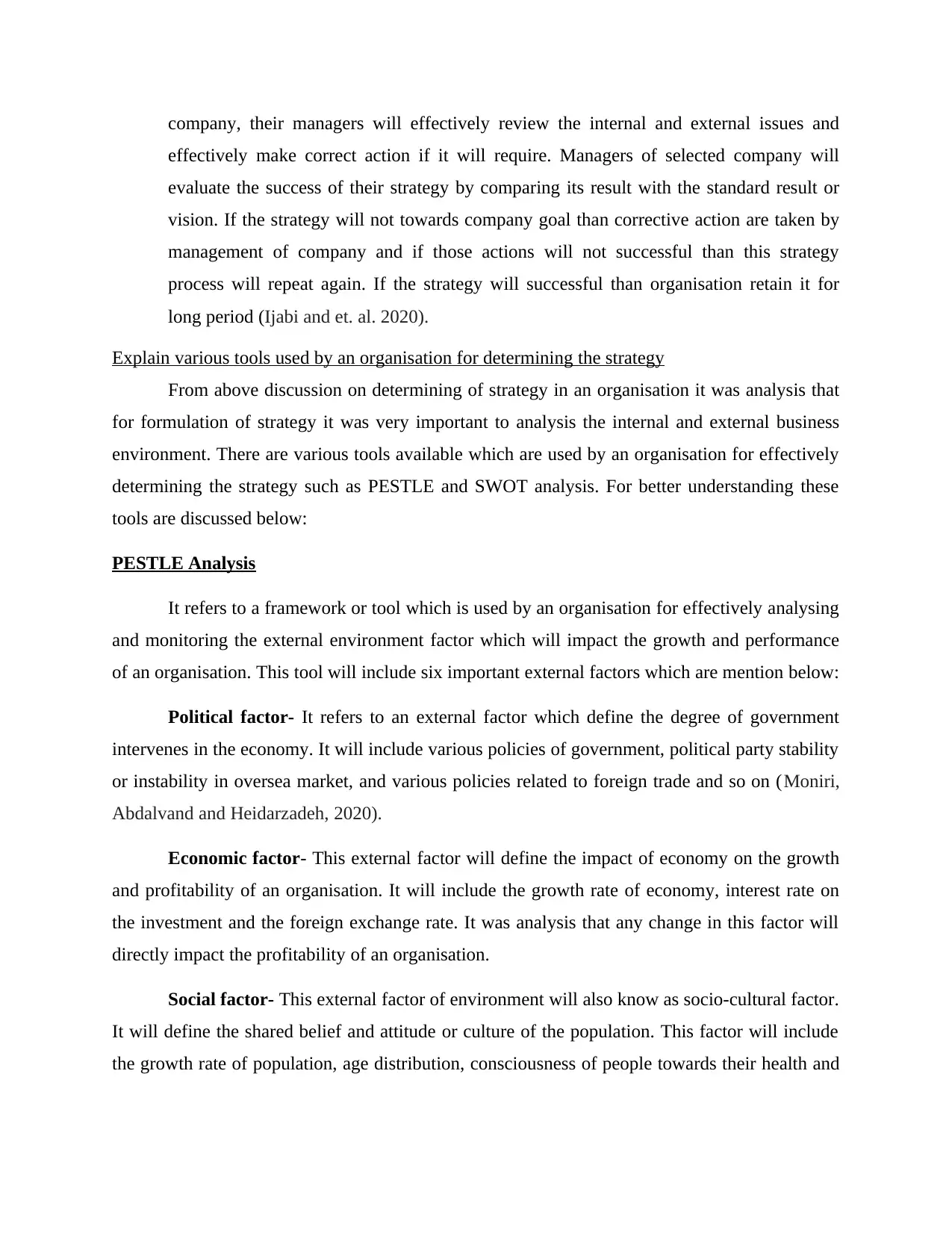
company, their managers will effectively review the internal and external issues and
effectively make correct action if it will require. Managers of selected company will
evaluate the success of their strategy by comparing its result with the standard result or
vision. If the strategy will not towards company goal than corrective action are taken by
management of company and if those actions will not successful than this strategy
process will repeat again. If the strategy will successful than organisation retain it for
long period (Ijabi and et. al. 2020).
Explain various tools used by an organisation for determining the strategy
From above discussion on determining of strategy in an organisation it was analysis that
for formulation of strategy it was very important to analysis the internal and external business
environment. There are various tools available which are used by an organisation for effectively
determining the strategy such as PESTLE and SWOT analysis. For better understanding these
tools are discussed below:
PESTLE Analysis
It refers to a framework or tool which is used by an organisation for effectively analysing
and monitoring the external environment factor which will impact the growth and performance
of an organisation. This tool will include six important external factors which are mention below:
Political factor- It refers to an external factor which define the degree of government
intervenes in the economy. It will include various policies of government, political party stability
or instability in oversea market, and various policies related to foreign trade and so on (Moniri,
Abdalvand and Heidarzadeh, 2020).
Economic factor- This external factor will define the impact of economy on the growth
and profitability of an organisation. It will include the growth rate of economy, interest rate on
the investment and the foreign exchange rate. It was analysis that any change in this factor will
directly impact the profitability of an organisation.
Social factor- This external factor of environment will also know as socio-cultural factor.
It will define the shared belief and attitude or culture of the population. This factor will include
the growth rate of population, age distribution, consciousness of people towards their health and
effectively make correct action if it will require. Managers of selected company will
evaluate the success of their strategy by comparing its result with the standard result or
vision. If the strategy will not towards company goal than corrective action are taken by
management of company and if those actions will not successful than this strategy
process will repeat again. If the strategy will successful than organisation retain it for
long period (Ijabi and et. al. 2020).
Explain various tools used by an organisation for determining the strategy
From above discussion on determining of strategy in an organisation it was analysis that
for formulation of strategy it was very important to analysis the internal and external business
environment. There are various tools available which are used by an organisation for effectively
determining the strategy such as PESTLE and SWOT analysis. For better understanding these
tools are discussed below:
PESTLE Analysis
It refers to a framework or tool which is used by an organisation for effectively analysing
and monitoring the external environment factor which will impact the growth and performance
of an organisation. This tool will include six important external factors which are mention below:
Political factor- It refers to an external factor which define the degree of government
intervenes in the economy. It will include various policies of government, political party stability
or instability in oversea market, and various policies related to foreign trade and so on (Moniri,
Abdalvand and Heidarzadeh, 2020).
Economic factor- This external factor will define the impact of economy on the growth
and profitability of an organisation. It will include the growth rate of economy, interest rate on
the investment and the foreign exchange rate. It was analysis that any change in this factor will
directly impact the profitability of an organisation.
Social factor- This external factor of environment will also know as socio-cultural factor.
It will define the shared belief and attitude or culture of the population. This factor will include
the growth rate of population, age distribution, consciousness of people towards their health and
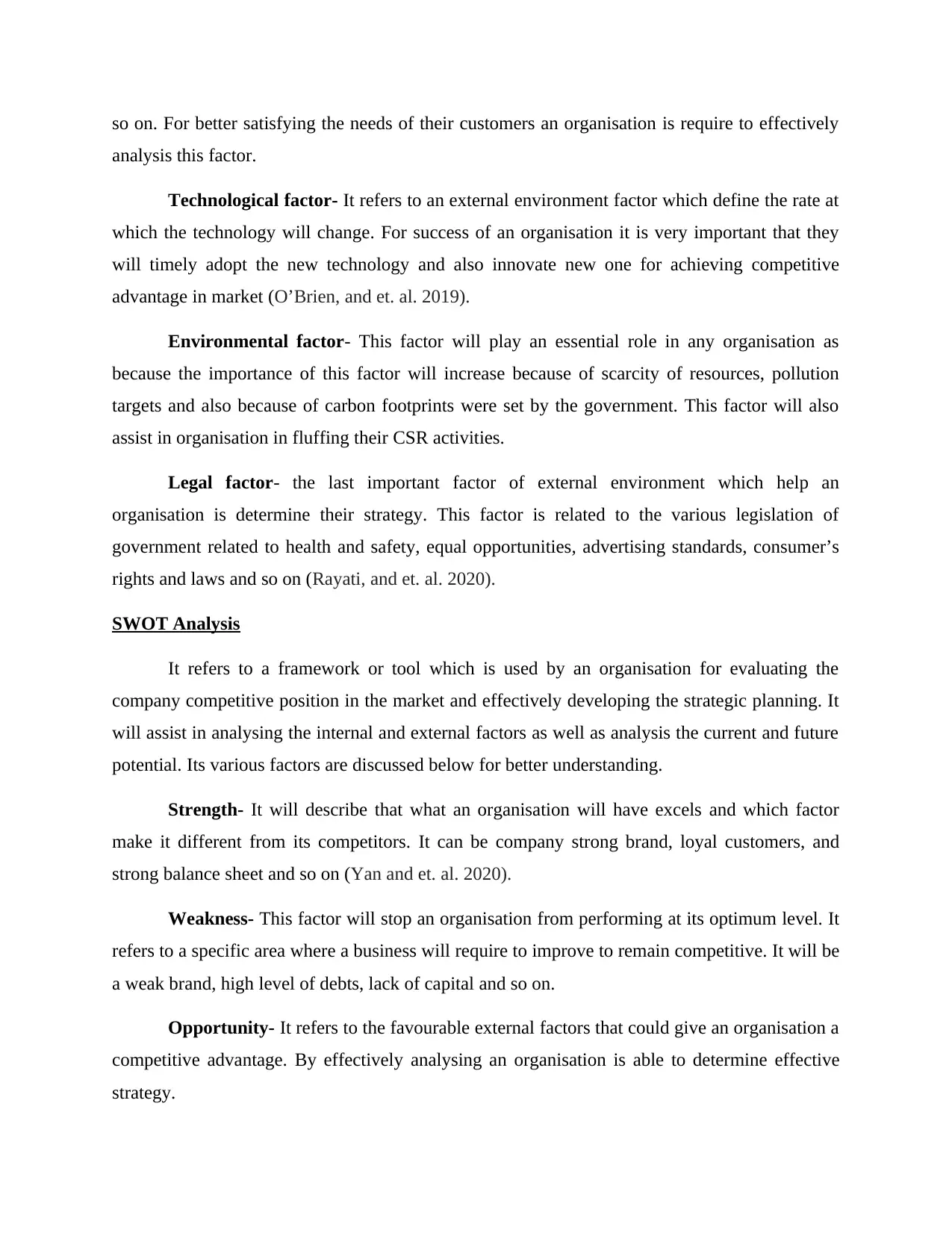
so on. For better satisfying the needs of their customers an organisation is require to effectively
analysis this factor.
Technological factor- It refers to an external environment factor which define the rate at
which the technology will change. For success of an organisation it is very important that they
will timely adopt the new technology and also innovate new one for achieving competitive
advantage in market (O’Brien, and et. al. 2019).
Environmental factor- This factor will play an essential role in any organisation as
because the importance of this factor will increase because of scarcity of resources, pollution
targets and also because of carbon footprints were set by the government. This factor will also
assist in organisation in fluffing their CSR activities.
Legal factor- the last important factor of external environment which help an
organisation is determine their strategy. This factor is related to the various legislation of
government related to health and safety, equal opportunities, advertising standards, consumer’s
rights and laws and so on (Rayati, and et. al. 2020).
SWOT Analysis
It refers to a framework or tool which is used by an organisation for evaluating the
company competitive position in the market and effectively developing the strategic planning. It
will assist in analysing the internal and external factors as well as analysis the current and future
potential. Its various factors are discussed below for better understanding.
Strength- It will describe that what an organisation will have excels and which factor
make it different from its competitors. It can be company strong brand, loyal customers, and
strong balance sheet and so on (Yan and et. al. 2020).
Weakness- This factor will stop an organisation from performing at its optimum level. It
refers to a specific area where a business will require to improve to remain competitive. It will be
a weak brand, high level of debts, lack of capital and so on.
Opportunity- It refers to the favourable external factors that could give an organisation a
competitive advantage. By effectively analysing an organisation is able to determine effective
strategy.
analysis this factor.
Technological factor- It refers to an external environment factor which define the rate at
which the technology will change. For success of an organisation it is very important that they
will timely adopt the new technology and also innovate new one for achieving competitive
advantage in market (O’Brien, and et. al. 2019).
Environmental factor- This factor will play an essential role in any organisation as
because the importance of this factor will increase because of scarcity of resources, pollution
targets and also because of carbon footprints were set by the government. This factor will also
assist in organisation in fluffing their CSR activities.
Legal factor- the last important factor of external environment which help an
organisation is determine their strategy. This factor is related to the various legislation of
government related to health and safety, equal opportunities, advertising standards, consumer’s
rights and laws and so on (Rayati, and et. al. 2020).
SWOT Analysis
It refers to a framework or tool which is used by an organisation for evaluating the
company competitive position in the market and effectively developing the strategic planning. It
will assist in analysing the internal and external factors as well as analysis the current and future
potential. Its various factors are discussed below for better understanding.
Strength- It will describe that what an organisation will have excels and which factor
make it different from its competitors. It can be company strong brand, loyal customers, and
strong balance sheet and so on (Yan and et. al. 2020).
Weakness- This factor will stop an organisation from performing at its optimum level. It
refers to a specific area where a business will require to improve to remain competitive. It will be
a weak brand, high level of debts, lack of capital and so on.
Opportunity- It refers to the favourable external factors that could give an organisation a
competitive advantage. By effectively analysing an organisation is able to determine effective
strategy.
⊘ This is a preview!⊘
Do you want full access?
Subscribe today to unlock all pages.

Trusted by 1+ million students worldwide
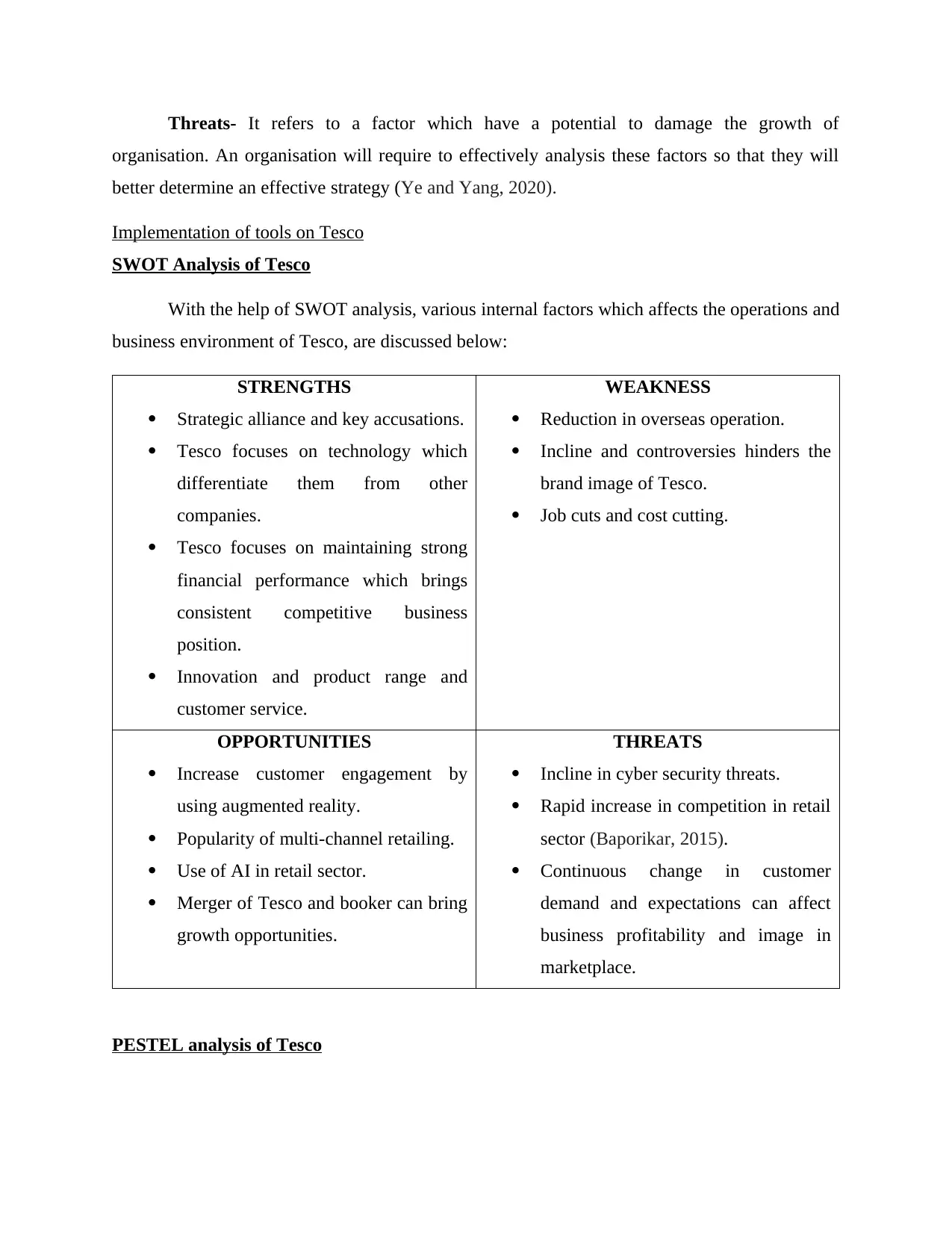
Threats- It refers to a factor which have a potential to damage the growth of
organisation. An organisation will require to effectively analysis these factors so that they will
better determine an effective strategy (Ye and Yang, 2020).
Implementation of tools on Tesco
SWOT Analysis of Tesco
With the help of SWOT analysis, various internal factors which affects the operations and
business environment of Tesco, are discussed below:
STRENGTHS
Strategic alliance and key accusations.
Tesco focuses on technology which
differentiate them from other
companies.
Tesco focuses on maintaining strong
financial performance which brings
consistent competitive business
position.
Innovation and product range and
customer service.
WEAKNESS
Reduction in overseas operation.
Incline and controversies hinders the
brand image of Tesco.
Job cuts and cost cutting.
OPPORTUNITIES
Increase customer engagement by
using augmented reality.
Popularity of multi-channel retailing.
Use of AI in retail sector.
Merger of Tesco and booker can bring
growth opportunities.
THREATS
Incline in cyber security threats.
Rapid increase in competition in retail
sector (Baporikar, 2015).
Continuous change in customer
demand and expectations can affect
business profitability and image in
marketplace.
PESTEL analysis of Tesco
organisation. An organisation will require to effectively analysis these factors so that they will
better determine an effective strategy (Ye and Yang, 2020).
Implementation of tools on Tesco
SWOT Analysis of Tesco
With the help of SWOT analysis, various internal factors which affects the operations and
business environment of Tesco, are discussed below:
STRENGTHS
Strategic alliance and key accusations.
Tesco focuses on technology which
differentiate them from other
companies.
Tesco focuses on maintaining strong
financial performance which brings
consistent competitive business
position.
Innovation and product range and
customer service.
WEAKNESS
Reduction in overseas operation.
Incline and controversies hinders the
brand image of Tesco.
Job cuts and cost cutting.
OPPORTUNITIES
Increase customer engagement by
using augmented reality.
Popularity of multi-channel retailing.
Use of AI in retail sector.
Merger of Tesco and booker can bring
growth opportunities.
THREATS
Incline in cyber security threats.
Rapid increase in competition in retail
sector (Baporikar, 2015).
Continuous change in customer
demand and expectations can affect
business profitability and image in
marketplace.
PESTEL analysis of Tesco
Paraphrase This Document
Need a fresh take? Get an instant paraphrase of this document with our AI Paraphraser
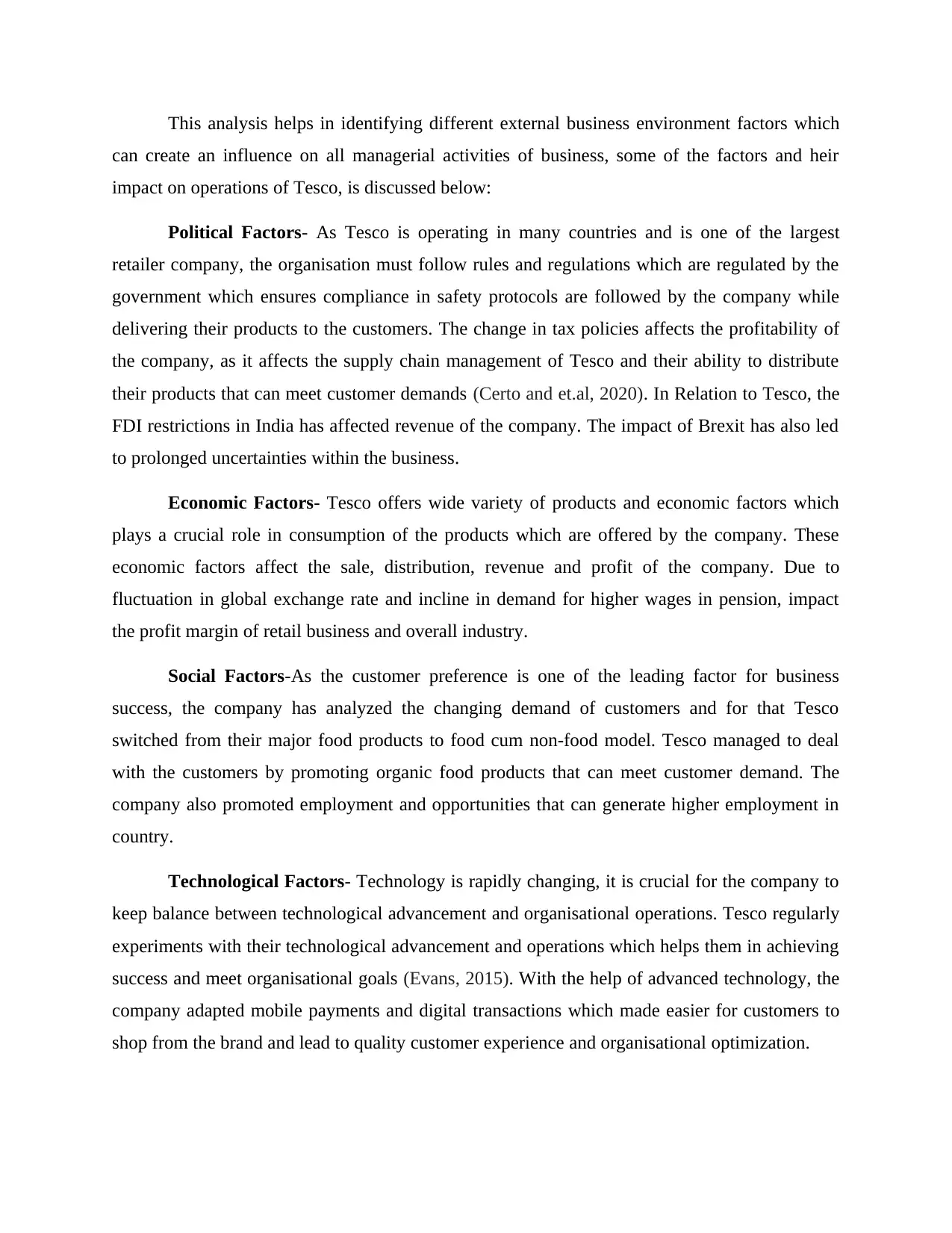
This analysis helps in identifying different external business environment factors which
can create an influence on all managerial activities of business, some of the factors and heir
impact on operations of Tesco, is discussed below:
Political Factors- As Tesco is operating in many countries and is one of the largest
retailer company, the organisation must follow rules and regulations which are regulated by the
government which ensures compliance in safety protocols are followed by the company while
delivering their products to the customers. The change in tax policies affects the profitability of
the company, as it affects the supply chain management of Tesco and their ability to distribute
their products that can meet customer demands (Certo and et.al, 2020). In Relation to Tesco, the
FDI restrictions in India has affected revenue of the company. The impact of Brexit has also led
to prolonged uncertainties within the business.
Economic Factors- Tesco offers wide variety of products and economic factors which
plays a crucial role in consumption of the products which are offered by the company. These
economic factors affect the sale, distribution, revenue and profit of the company. Due to
fluctuation in global exchange rate and incline in demand for higher wages in pension, impact
the profit margin of retail business and overall industry.
Social Factors-As the customer preference is one of the leading factor for business
success, the company has analyzed the changing demand of customers and for that Tesco
switched from their major food products to food cum non-food model. Tesco managed to deal
with the customers by promoting organic food products that can meet customer demand. The
company also promoted employment and opportunities that can generate higher employment in
country.
Technological Factors- Technology is rapidly changing, it is crucial for the company to
keep balance between technological advancement and organisational operations. Tesco regularly
experiments with their technological advancement and operations which helps them in achieving
success and meet organisational goals (Evans, 2015). With the help of advanced technology, the
company adapted mobile payments and digital transactions which made easier for customers to
shop from the brand and lead to quality customer experience and organisational optimization.
can create an influence on all managerial activities of business, some of the factors and heir
impact on operations of Tesco, is discussed below:
Political Factors- As Tesco is operating in many countries and is one of the largest
retailer company, the organisation must follow rules and regulations which are regulated by the
government which ensures compliance in safety protocols are followed by the company while
delivering their products to the customers. The change in tax policies affects the profitability of
the company, as it affects the supply chain management of Tesco and their ability to distribute
their products that can meet customer demands (Certo and et.al, 2020). In Relation to Tesco, the
FDI restrictions in India has affected revenue of the company. The impact of Brexit has also led
to prolonged uncertainties within the business.
Economic Factors- Tesco offers wide variety of products and economic factors which
plays a crucial role in consumption of the products which are offered by the company. These
economic factors affect the sale, distribution, revenue and profit of the company. Due to
fluctuation in global exchange rate and incline in demand for higher wages in pension, impact
the profit margin of retail business and overall industry.
Social Factors-As the customer preference is one of the leading factor for business
success, the company has analyzed the changing demand of customers and for that Tesco
switched from their major food products to food cum non-food model. Tesco managed to deal
with the customers by promoting organic food products that can meet customer demand. The
company also promoted employment and opportunities that can generate higher employment in
country.
Technological Factors- Technology is rapidly changing, it is crucial for the company to
keep balance between technological advancement and organisational operations. Tesco regularly
experiments with their technological advancement and operations which helps them in achieving
success and meet organisational goals (Evans, 2015). With the help of advanced technology, the
company adapted mobile payments and digital transactions which made easier for customers to
shop from the brand and lead to quality customer experience and organisational optimization.
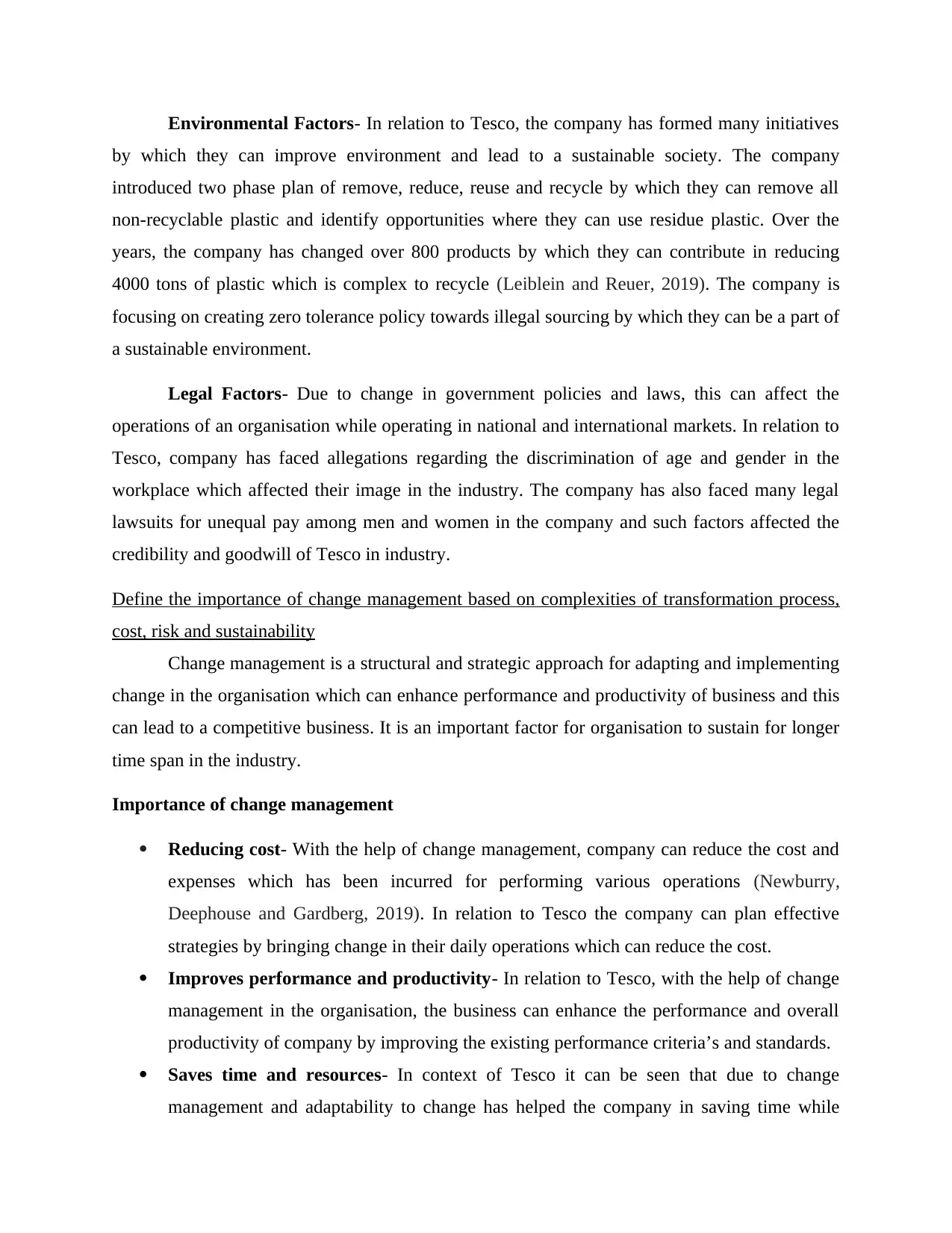
Environmental Factors- In relation to Tesco, the company has formed many initiatives
by which they can improve environment and lead to a sustainable society. The company
introduced two phase plan of remove, reduce, reuse and recycle by which they can remove all
non-recyclable plastic and identify opportunities where they can use residue plastic. Over the
years, the company has changed over 800 products by which they can contribute in reducing
4000 tons of plastic which is complex to recycle (Leiblein and Reuer, 2019). The company is
focusing on creating zero tolerance policy towards illegal sourcing by which they can be a part of
a sustainable environment.
Legal Factors- Due to change in government policies and laws, this can affect the
operations of an organisation while operating in national and international markets. In relation to
Tesco, company has faced allegations regarding the discrimination of age and gender in the
workplace which affected their image in the industry. The company has also faced many legal
lawsuits for unequal pay among men and women in the company and such factors affected the
credibility and goodwill of Tesco in industry.
Define the importance of change management based on complexities of transformation process,
cost, risk and sustainability
Change management is a structural and strategic approach for adapting and implementing
change in the organisation which can enhance performance and productivity of business and this
can lead to a competitive business. It is an important factor for organisation to sustain for longer
time span in the industry.
Importance of change management
Reducing cost- With the help of change management, company can reduce the cost and
expenses which has been incurred for performing various operations (Newburry,
Deephouse and Gardberg, 2019). In relation to Tesco the company can plan effective
strategies by bringing change in their daily operations which can reduce the cost.
Improves performance and productivity- In relation to Tesco, with the help of change
management in the organisation, the business can enhance the performance and overall
productivity of company by improving the existing performance criteria’s and standards.
Saves time and resources- In context of Tesco it can be seen that due to change
management and adaptability to change has helped the company in saving time while
by which they can improve environment and lead to a sustainable society. The company
introduced two phase plan of remove, reduce, reuse and recycle by which they can remove all
non-recyclable plastic and identify opportunities where they can use residue plastic. Over the
years, the company has changed over 800 products by which they can contribute in reducing
4000 tons of plastic which is complex to recycle (Leiblein and Reuer, 2019). The company is
focusing on creating zero tolerance policy towards illegal sourcing by which they can be a part of
a sustainable environment.
Legal Factors- Due to change in government policies and laws, this can affect the
operations of an organisation while operating in national and international markets. In relation to
Tesco, company has faced allegations regarding the discrimination of age and gender in the
workplace which affected their image in the industry. The company has also faced many legal
lawsuits for unequal pay among men and women in the company and such factors affected the
credibility and goodwill of Tesco in industry.
Define the importance of change management based on complexities of transformation process,
cost, risk and sustainability
Change management is a structural and strategic approach for adapting and implementing
change in the organisation which can enhance performance and productivity of business and this
can lead to a competitive business. It is an important factor for organisation to sustain for longer
time span in the industry.
Importance of change management
Reducing cost- With the help of change management, company can reduce the cost and
expenses which has been incurred for performing various operations (Newburry,
Deephouse and Gardberg, 2019). In relation to Tesco the company can plan effective
strategies by bringing change in their daily operations which can reduce the cost.
Improves performance and productivity- In relation to Tesco, with the help of change
management in the organisation, the business can enhance the performance and overall
productivity of company by improving the existing performance criteria’s and standards.
Saves time and resources- In context of Tesco it can be seen that due to change
management and adaptability to change has helped the company in saving time while
⊘ This is a preview!⊘
Do you want full access?
Subscribe today to unlock all pages.

Trusted by 1+ million students worldwide
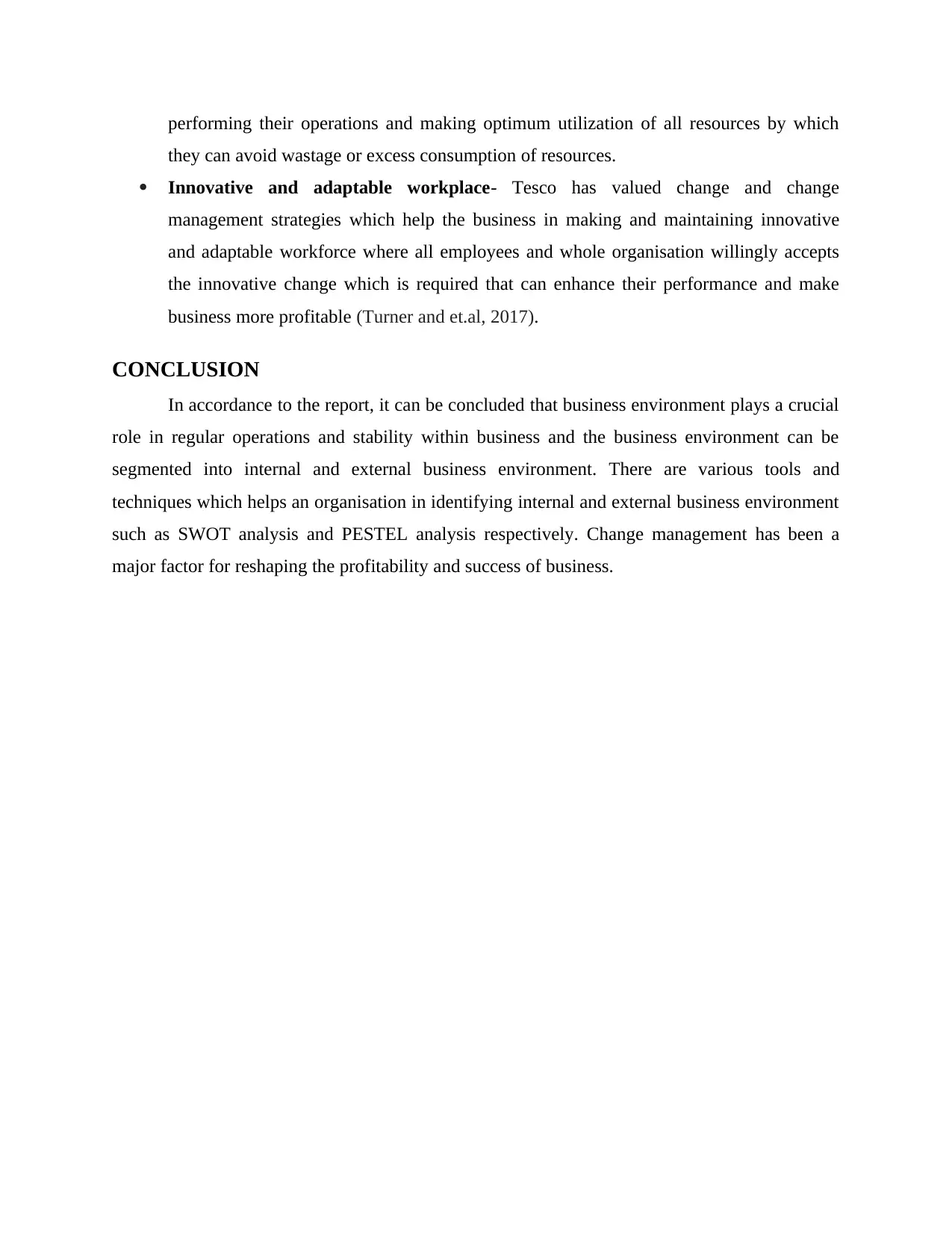
performing their operations and making optimum utilization of all resources by which
they can avoid wastage or excess consumption of resources.
Innovative and adaptable workplace- Tesco has valued change and change
management strategies which help the business in making and maintaining innovative
and adaptable workforce where all employees and whole organisation willingly accepts
the innovative change which is required that can enhance their performance and make
business more profitable (Turner and et.al, 2017).
CONCLUSION
In accordance to the report, it can be concluded that business environment plays a crucial
role in regular operations and stability within business and the business environment can be
segmented into internal and external business environment. There are various tools and
techniques which helps an organisation in identifying internal and external business environment
such as SWOT analysis and PESTEL analysis respectively. Change management has been a
major factor for reshaping the profitability and success of business.
they can avoid wastage or excess consumption of resources.
Innovative and adaptable workplace- Tesco has valued change and change
management strategies which help the business in making and maintaining innovative
and adaptable workforce where all employees and whole organisation willingly accepts
the innovative change which is required that can enhance their performance and make
business more profitable (Turner and et.al, 2017).
CONCLUSION
In accordance to the report, it can be concluded that business environment plays a crucial
role in regular operations and stability within business and the business environment can be
segmented into internal and external business environment. There are various tools and
techniques which helps an organisation in identifying internal and external business environment
such as SWOT analysis and PESTEL analysis respectively. Change management has been a
major factor for reshaping the profitability and success of business.
Paraphrase This Document
Need a fresh take? Get an instant paraphrase of this document with our AI Paraphraser
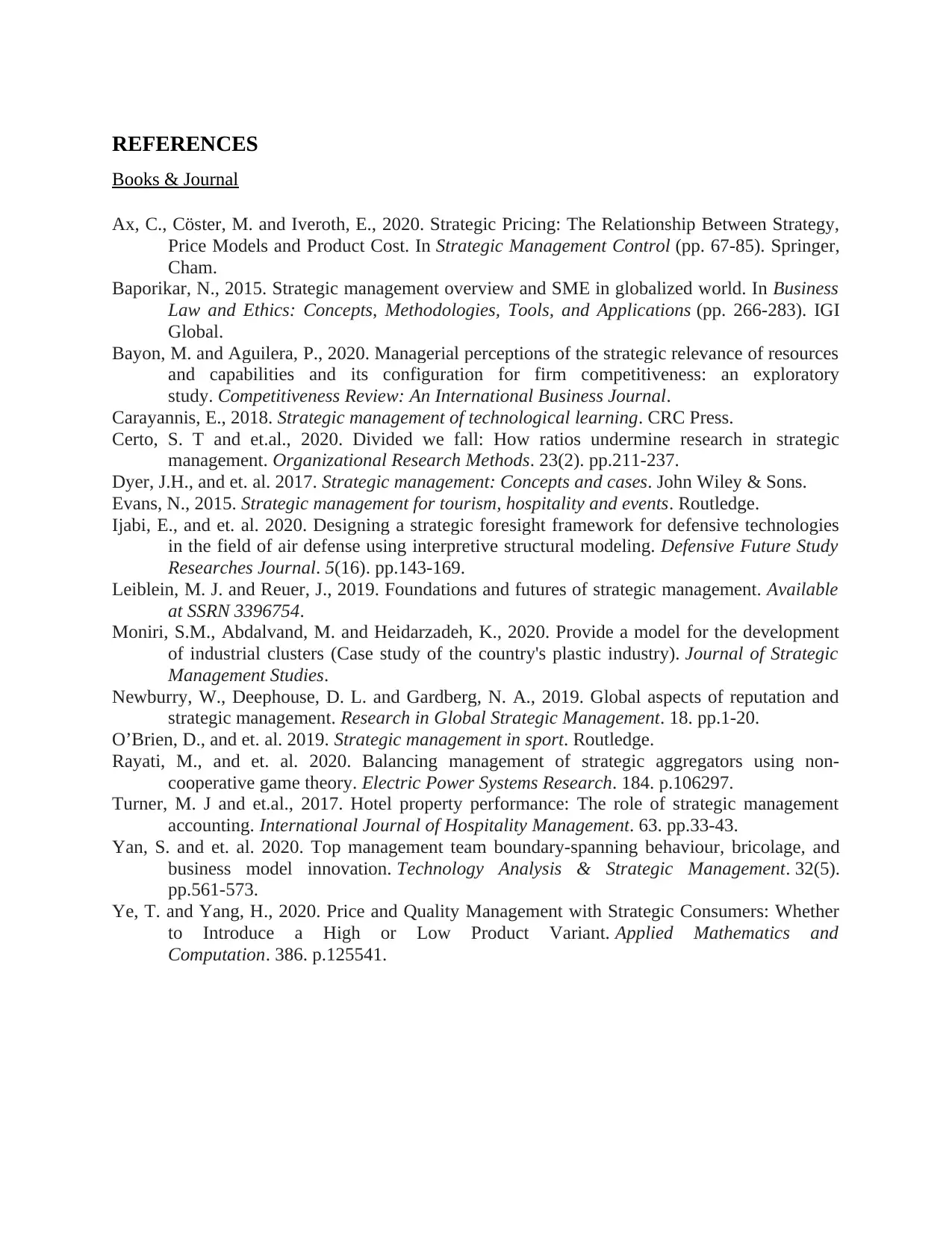
REFERENCES
Books & Journal
Ax, C., Cöster, M. and Iveroth, E., 2020. Strategic Pricing: The Relationship Between Strategy,
Price Models and Product Cost. In Strategic Management Control (pp. 67-85). Springer,
Cham.
Baporikar, N., 2015. Strategic management overview and SME in globalized world. In Business
Law and Ethics: Concepts, Methodologies, Tools, and Applications (pp. 266-283). IGI
Global.
Bayon, M. and Aguilera, P., 2020. Managerial perceptions of the strategic relevance of resources
and capabilities and its configuration for firm competitiveness: an exploratory
study. Competitiveness Review: An International Business Journal.
Carayannis, E., 2018. Strategic management of technological learning. CRC Press.
Certo, S. T and et.al., 2020. Divided we fall: How ratios undermine research in strategic
management. Organizational Research Methods. 23(2). pp.211-237.
Dyer, J.H., and et. al. 2017. Strategic management: Concepts and cases. John Wiley & Sons.
Evans, N., 2015. Strategic management for tourism, hospitality and events. Routledge.
Ijabi, E., and et. al. 2020. Designing a strategic foresight framework for defensive technologies
in the field of air defense using interpretive structural modeling. Defensive Future Study
Researches Journal. 5(16). pp.143-169.
Leiblein, M. J. and Reuer, J., 2019. Foundations and futures of strategic management. Available
at SSRN 3396754.
Moniri, S.M., Abdalvand, M. and Heidarzadeh, K., 2020. Provide a model for the development
of industrial clusters (Case study of the country's plastic industry). Journal of Strategic
Management Studies.
Newburry, W., Deephouse, D. L. and Gardberg, N. A., 2019. Global aspects of reputation and
strategic management. Research in Global Strategic Management. 18. pp.1-20.
O’Brien, D., and et. al. 2019. Strategic management in sport. Routledge.
Rayati, M., and et. al. 2020. Balancing management of strategic aggregators using non-
cooperative game theory. Electric Power Systems Research. 184. p.106297.
Turner, M. J and et.al., 2017. Hotel property performance: The role of strategic management
accounting. International Journal of Hospitality Management. 63. pp.33-43.
Yan, S. and et. al. 2020. Top management team boundary-spanning behaviour, bricolage, and
business model innovation. Technology Analysis & Strategic Management. 32(5).
pp.561-573.
Ye, T. and Yang, H., 2020. Price and Quality Management with Strategic Consumers: Whether
to Introduce a High or Low Product Variant. Applied Mathematics and
Computation. 386. p.125541.
Books & Journal
Ax, C., Cöster, M. and Iveroth, E., 2020. Strategic Pricing: The Relationship Between Strategy,
Price Models and Product Cost. In Strategic Management Control (pp. 67-85). Springer,
Cham.
Baporikar, N., 2015. Strategic management overview and SME in globalized world. In Business
Law and Ethics: Concepts, Methodologies, Tools, and Applications (pp. 266-283). IGI
Global.
Bayon, M. and Aguilera, P., 2020. Managerial perceptions of the strategic relevance of resources
and capabilities and its configuration for firm competitiveness: an exploratory
study. Competitiveness Review: An International Business Journal.
Carayannis, E., 2018. Strategic management of technological learning. CRC Press.
Certo, S. T and et.al., 2020. Divided we fall: How ratios undermine research in strategic
management. Organizational Research Methods. 23(2). pp.211-237.
Dyer, J.H., and et. al. 2017. Strategic management: Concepts and cases. John Wiley & Sons.
Evans, N., 2015. Strategic management for tourism, hospitality and events. Routledge.
Ijabi, E., and et. al. 2020. Designing a strategic foresight framework for defensive technologies
in the field of air defense using interpretive structural modeling. Defensive Future Study
Researches Journal. 5(16). pp.143-169.
Leiblein, M. J. and Reuer, J., 2019. Foundations and futures of strategic management. Available
at SSRN 3396754.
Moniri, S.M., Abdalvand, M. and Heidarzadeh, K., 2020. Provide a model for the development
of industrial clusters (Case study of the country's plastic industry). Journal of Strategic
Management Studies.
Newburry, W., Deephouse, D. L. and Gardberg, N. A., 2019. Global aspects of reputation and
strategic management. Research in Global Strategic Management. 18. pp.1-20.
O’Brien, D., and et. al. 2019. Strategic management in sport. Routledge.
Rayati, M., and et. al. 2020. Balancing management of strategic aggregators using non-
cooperative game theory. Electric Power Systems Research. 184. p.106297.
Turner, M. J and et.al., 2017. Hotel property performance: The role of strategic management
accounting. International Journal of Hospitality Management. 63. pp.33-43.
Yan, S. and et. al. 2020. Top management team boundary-spanning behaviour, bricolage, and
business model innovation. Technology Analysis & Strategic Management. 32(5).
pp.561-573.
Ye, T. and Yang, H., 2020. Price and Quality Management with Strategic Consumers: Whether
to Introduce a High or Low Product Variant. Applied Mathematics and
Computation. 386. p.125541.
1 out of 11
Related Documents
Your All-in-One AI-Powered Toolkit for Academic Success.
+13062052269
info@desklib.com
Available 24*7 on WhatsApp / Email
![[object Object]](/_next/static/media/star-bottom.7253800d.svg)
Unlock your academic potential
Copyright © 2020–2025 A2Z Services. All Rights Reserved. Developed and managed by ZUCOL.



